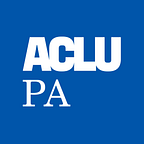Philly Stops and Frisks are Down, but Continue Nonetheless
By Reggie Shuford, Executive Director, ACLU of Pennsylvania
The police practice of stop-and-frisk continues to be highly controversial in Philadelphia. The good news is that it isn’t quite as rampant as it was, and there is limited progress. The bad news is that the stopping and frisking of pedestrians on the street continue at a rate dramatically higher than that of New York and other cities. And substantial racial disparities that are not explained by crime rates or police deployment are still evident, as Black Philadelphians are disproportionately impacted and account for most of those targeted by law enforcement.
On January 8, lawyers for the plaintiffs in the 2010 case Bailey v. Philadelphia filed a report in federal court which tracks stop-and-frisk data for the first half of 2017. The suit — filed by the ACLU of Pennsylvania, the law firm of Kairys, Rudovsky, Messing, Feinberg and Lin LLP, and Seth Kreimer, a law professor at the University of Pennsylvania School of Law — alleged that the Philadelphia Police Department maintained a pattern and practice of stopping and frisking citizens without a reasonable suspicion they were involved in criminal activity. The suit also alleged the police disproportionately stop Black and Latino pedestrians.
Under a 2011 consent decree in the case, the police can make stops only when there is a reasonable suspicion of criminal conduct and frisk people only when there is a reasonable suspicion the suspect is armed and dangerous. And the police may not act based on the person’s race or ethnicity.
The report found that the police have a long way to go in following the consent decree. While the number of stops has been reduced by half over seven years, still there were 20,000 people stopped in 2017 without a justifiable reason, and two of every five frisks occur without cause. Members of racial minorities are targeted far more than their share of the population, and the new analysis shows that this disproportionate impact remains after controlling for other, non-racial factors.
For the first half of 2017, 86 percent of those detained by police were male, and the median age was 33. Black people account for 69 percent of the stops, even while they are just 44 percent of the population. Whites, who are 45 percent of the city’s population, are only 22 percent of the stops. Latinos, who are 14 percent of Philadelphia’s population, account for 9 percent of stops.
People of color comprise an even larger share of those who are frisked, as 77 percent are Black, 10 percent are Latino and 12 percent are White. In addition, while 1 in 10.8 stops for White pedestrians results in a frisk, the rate is merely 1 in 5.5 stops for Blacks.
The report, which analyzed data from 64 police service areas, or PSAs, within the city, also revealed that Blacks account for a disproportionate share of stops in all but five PSAs. “For example, in PSA 91, the population is only 3% Black, but 67% of stops were of Blacks. In PSA 63, the population is 7% Black and 68% of stops were of Blacks,” according to the report. “By contrast, in PSA 192, where Blacks make up 96% of the population, the ratio of Black stops to Black population was close to a 1:1 ratio.”
According to the report, there is “strong evidence” that non-racial factors will not explain the huge differences in stop-and-frisk rates by race in Philadelphia. “To the contrary, the data show statistically significant racial disparities that in almost all respects are not explainable by non-racial factors,” said the authors of the report.
Moreover, the data betray the police narrative that police must perform these stops and frisks to retrieve contraband, including guns and drugs. Contraband was found in 9 percent of frisks, with only 1 in 49 frisks yielding a firearm and 1 in 18 frisks resulting in drugs. These glaring numbers underscore the need for the federal consent decree, and highlight the abject failure of a law enforcement practice that is racially discriminatory and is unrelated to and ineffective at fighting crime.
Observing the situation in New York, Kyle Smith of the National Review admitted recently that he was wrong about the need for stop-and-frisk in that city, noting that crime has fallen as police abandoned the tactic and did not rise as they had expected. Homicides in New York were down 12 percent in 2017 — nearly a record low — while stops and frisks fell a dramatic 98 percent from their peak in 2011. Courts did their part to end the practice among NYPD officers. Meanwhile, as the Bailey consent decree report noted, “Philadelphia’s per capita stop rate is currently vastly higher than that in New York and some other major cities.”
Fewer pedestrians are detained by police in Philadelphia, and we should applaud that. Yet, thousands of people are subjected to stops and frisks because of their race — without cause and without justification — and we must demand better.
